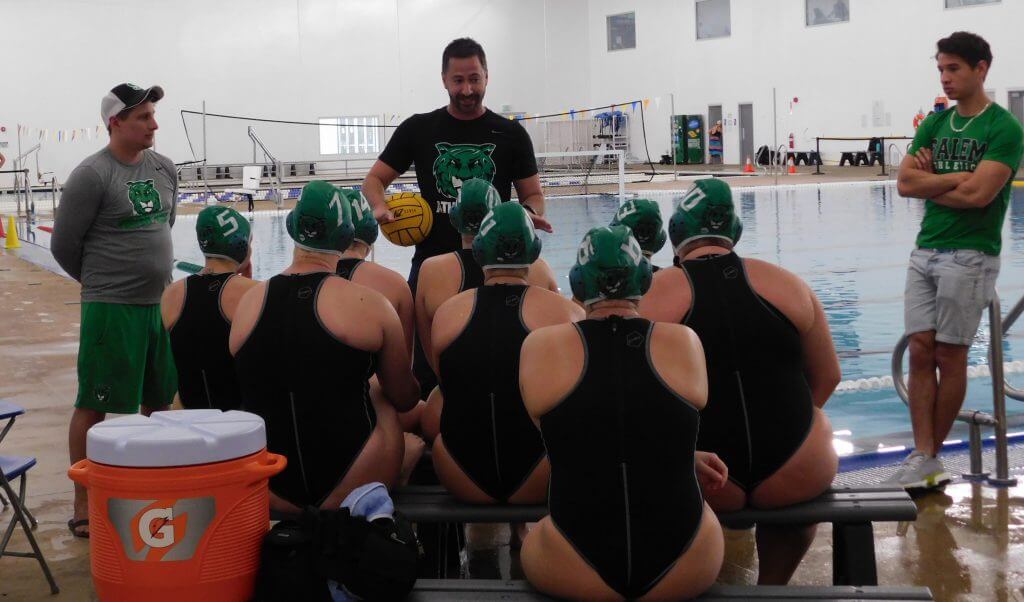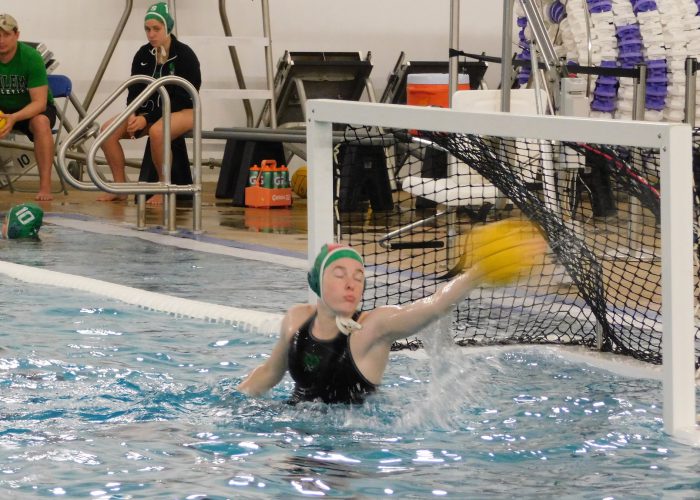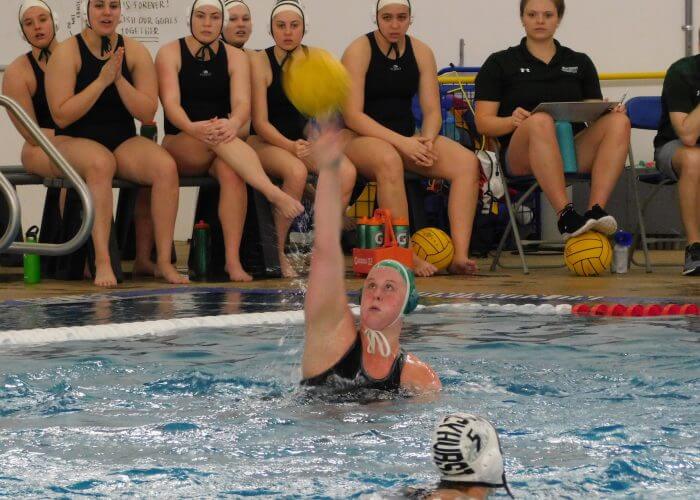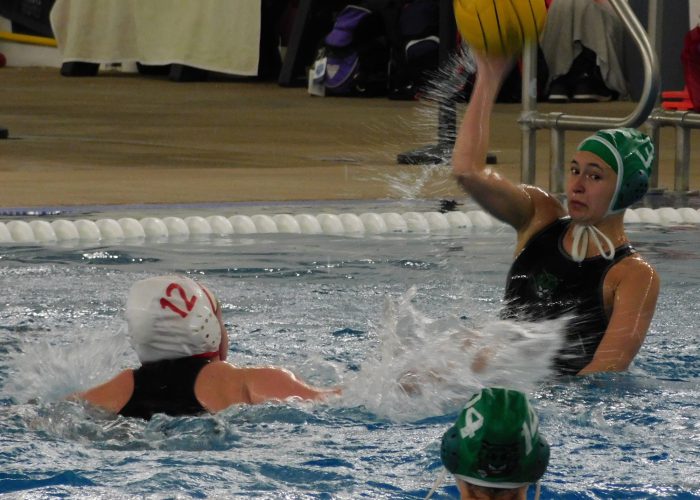On The Record with Justin Kassab, Head Coach For Salem Women’s Water Polo

The past few years there’s been a wave of new men’s and women’s intercollegiate polo programs cropping up, primarily outside of California, the home base for much of American water polo. One program that has risen, again, to the NCAA varsity ranks are the Tigers of Salem University in West Virginia.
[The (Growth) Beat Goes on: Urbana University to Add Women’s Water Polo in 2020]
Now in its third iteration—after subsequent programs were shut down in 2006 and 2012—Salem has been an inspirational story for 2019. Head Coach Justin Kassab has assembled a talented, though not deep, squad that not only finished the regular season with a winning record (13-12; 2-1 WWPA), did so with a flourish, winning seven-straight.
 Playing this weekend in their inaugural Western Water Polo Association (WWPA) Championships, the Tigers and their spirited coach hope to make history by winning their first-ever post-season match in WWPA play. (Salem dropped a tough 6-5 decision to CSEB in Friday)
Playing this weekend in their inaugural Western Water Polo Association (WWPA) Championships, the Tigers and their spirited coach hope to make history by winning their first-ever post-season match in WWPA play. (Salem dropped a tough 6-5 decision to CSEB in Friday)
Swimming World caught up with Coach Kassab earlier this week as he was preparing for a first round match against Cal State East Bay at the Spire Center in Geneva, OH.
– This is not the first time for Salem women’s water polo but it’s your inaugural run as a head coach.
I’ve been a career assistant coach my entire life at all levels until this opportunity arose. My background in the sport is: I was a cut soccer goalie, my sophomore year in high school, and my goalie coach in high school was a Slippery Rock grad who played for Doc Hunkler. He said: You’ve got to make a choice now; you can choose to come to water polo and be a varsity athlete or keep chasing soccer and see how that goes for you.
I started off my career as a goalies’ coach for Jim Yeamans when I was at Slippery Rock as a student. He had me working with the women’s team. Then from 2009 until roughly 2016 I bounced around between Cumberland Valley, Kingfish, Mechanicsburg and anywhere else in Pennsylvania that needs some goalie help.
I got lucky enough that Rob [Bullion] here on the men’s side was looking for an assistant coach to help out. I took the opportunity to come up here to the next level and it’s paid off with Salem bringing on a women’s water polo program.
[Mid-Atlantic Water Polo Conference Report: Salem University’s Eclectic Water Polo Program]
– What was your role in shepherding this new team from idea to reality?
One thing I’m really lucky for here—and is rare in the aquatics world—is I have an aquatics director and an athletics director who support aquatics 100%. Rob Bullion, the men’s coach, is also our aquatics director. When he brought me on it was the first year we had brought on men’s and women’s swimming. I also have a background in coaching swimming, so one of my duties was assisting with the swim team.

Philippa Piper has stood tall in the Tigers’ cage. Photo Courtesy: Salem Athletics
He told me what his plan was: we have a solid water polo program, now we’ve got to build a swim team. Once we have a swim team up and running then we’ve got to bring on women’s water polo.
From when I started under Rob the plan was to eventually shift me to the women’s water polo program. The timeline was the questions mark.
– This latest iteration of Tiger women’s water polo has had outsized success. How has this first year progressed?
I’d be lying if I said there’s a lot of lows this season—because I saw everyone’s expectation for us to be the bottom of the barrel with the WWPA, which would put us pretty low in the country. Saying you’re the worst Division II [team] in the country sets a pretty low standard for you. I intentionally built a very difficult schedule for our women. Of our first 18 games, I think roughly 14 of them were DI opponents and at least five of them were nationally ranked.
As I explained it to the girls, we’re playing for the last three games of the season. We can go 3-25 and still go to NCAAs. Every game we play against a better opponent makes us a better team, and our big challenge this year was we were running with nine girls—we have 10 on the roster—one unfortunately (Erika Cates) was injured out pretty much the entire year. Of those nine, eight are freshmen and one’s a junior. We were running two subs and some of those weekends we’re playing five games—so the fact that we survived some of those games was impressive of itself.
But we didn’t just survive, we thrived. We took down Villanova, we took down La Salle. We’ve taken down McKendree and Mercyhurst every time we’ve seen them, and they’re conference rivals. Arguably the worst game of the season—and I don’t want to take anything away from Gannon because they played beautifully against us—but one DII game that I feel we should have had this year was that Gannon game.
A high point this season—and I know that it’s going to sound stupid to say that a loss is a high point—we played Indiana to five goals (14-9 loss). They pulled no punches against us, they player their starting line, starting goalie the entire time. That was one of those games I took a picture of the scoreboard afterwards because our girls played beautifully the whole way through. When you run nine girls against 22 girls it’s a war of attrition. It’s amazing to me that my girls have that fight in them.
I explained to them from game one; we have to be as strong as three players, as fast as three players and be as smart as three players—and every single one of my girls has risen up to that.
– With a core of foreign-born players who know the game, your team had an edge going into the season.
We have 10 on the roster, three are from the U.S. and seven internationals, who are predominantly Australian—[meaning] three people have played in the same system. One of the hardest things starting out was getting everyone on the same level of communication. Australians number the field differently than Americans do, then Romanians, Greeks or Italians do. We had all different numbering systems and it came to a point where I said: Ladies, look: we have three Australians in the water. We’re gonna use their system. It’s what’s going to be natural.
Bringing in that many internationals, I followed Rob’s layout with the men’s team. We’re a very small campus in West Virginia, which isn’t always an easy sell to a domestic kid, but for an international kid hungry for an American education and to play some water polo, it’s a great place. That was one of my primary focuses—trying to build a squad off of an international base. No two of them came to me the same way. Sometime recruiters reached out and I happened to be the right person, so when these girls reached out.

Chloe Woodbine never played for Hartwick and has been a mainstay for Salem. Photo Courtesy: Salem Athletics
Obviously, when Chloe [Woodbine] and Maryanna [Antoniou] announced they were leaving [Hartwick] I reached out to Alan—the good, old Slippery Rock network—and let him know I’d be happy to provide a landing pad for any of his girls. Going through Slippery Rock being cut I tried to help out as much as possible.
[Broken Trust: Hartwick College Eliminates Women’s Water Polo]
The other thing with that is almost every international [athlete] I have came to me sight unseen. We never met in person, I had never watched them play in person; it was just game tape or live streams. With the level of talent I got I couldn’t have been any more lucky.
Bringing them in together, I attribute that to a lot of sleepless nights and a lot of luck. That year any of my recruits will tell you, if they messaged me at 3 a.m. I was up for them. I didn’t sleep a whole lot last year; I continued to look for the best fit for the Salem program.
One of the big things when you’re building a brand-new program was making sure that the girls were going to fit me. No one’s going to walk in and know what to do automatically. In an established program, you have your seniors who totally understand what you’re doing, your juniors mostly understand, your sophomores kind of understand and your freshmen are clueless. I needed to find girls I could trust who were going to buy into my system. As my girls have said: Coach, you’re as good as you are because you’re crazier than most!

Margherita Garibbo and Annefleur ten Bloemendal. Photo Courtesy: Salem Athletics
I reverse engineer everything from the goalie’s standpoint so that it makes sense to me. There’s times I’ll ask them to do something that’s completely illogical but—sometimes it works, sometimes it doesn’t. I had to find kids who would buy into that—I [don’t have] a rigid offensive system. When I played at Slippery Rock we had a great offense and a lot of that was just chemistry. Which was one of our weaknesses early on this season—finding that chemistry, communicating with each other. Each game that got better and better and we’re at a point where my girls are pretty good playing blind with each other. They don’t have to communicate; they know what each other’s going to do.
One of the really fun things about this year has been, of those 10 girls, all but four came in as centers. I had to develop a game plan for when we had an entire starting line-up of centers. I got lucky—some of my centers were more utility builds. It’s been a lot of fun developing our offense around what can we do best.
Sometimes I feel like we’re the Island of Misfit Toys and it just happens to work out.
– Your team can generate offense—especially Margherita Garibbo (65 goals, 36 assists), Annefleur ten Bloemendal (69 goals) and Antoniou (42 goals). How did you get your players to be so effective on this side of the ball?
My motto to my girls is: we’re gonna let our opponents pick how we’re going to beat them. Those top three scorers are great and they’re productive, but that’s only because of whoever the other three girls are in the water at that time. Our two primary centers are Chloe and Beatrice Popescu. Those two always draw double coverage; when that happens, I have some really good outside shooters. Even though they’re centers, a lot of my focus was outside shooting with a shot-blocker in your way, and you hit your corners.
One of the great things about having been a goalie coach is I break-down the other goalie’s weaknesses and teach my girls how to shoot appropriately. There’s been a lot of hands-on with this.
My main focus with the offense was to re-train my centers to be outside shooters, and we do a lot of work either shifting into a double center or running straight into a double center to begin with—because we have an abundance of them.
Across the East Coast there’s some really good center defenders—but there’s very few teams that have two – three really good center defenders. As long as I can get two centers in there, we’ll have a decent mismatch. A lot of our offense is based around creating mismatches and taking the right opportunities from the perimeter.
– Later today the Tigers will face #3 Cal State East Bay in the first round of the WWPA playoffs. Your team lost to the Pioneers a month ago, getting down early. What will it take to win on Friday?
They have one great advantage on us and that’s Lisa [Cooper]. She’s been around almost two decades now and they’re a well-run, very strong team. [The game against] East Bay was the turning point of our season. They were the first team to beat us in a new way, and we’ve adjusted our playing style since. It was a game that we did not play to the best of our ability. We went 0-7 on our man-ups—the focus this time is to make sure we capitalize with the man-advantage. And making sure we’re not giving away opportunities; we did a very bad job with our good opportunities and a bad job giving [Cal State] good opportunities.

Tanya Lopez. Photo Courtesy: Salem Athletics
When you have freshmen, they make freshman mistakes. If you have an entire starting line-up of freshmen, the big thing is how to minimize those mistakes as we move forward. This time. it’s a matter of minimizing our rookie mistakes and capitalizing on our opportunities.
– Your team has finished strong; how much will that confidence help in playing in your first-ever WWPA post-season match.
I preach that all games are the same—championship game or exhibition game. We treat ‘em all the same. It’s great that we’re on a seven-game winning streak, but if we came in on a seven-game losing streak I’d treat this same. It’s the same amount of minutes, same amount of shot clocks, the same goals. If you score more goals than your opponent, you win.
I really don’t try and build up on that—though I know momentum’s a huge thing—because as long as I keep the team even keel, that will help us succeed.
– How has Maryanna Antoniou’s experience playing for a strong program like Hartwick helped stabilize your young roster?
Maryanna and Chloe have been my two captains throughout the year and they’re my two Hartwick transfers. Talking about the international side, there’s a big difference between FINA and the NCAAs. One the biggest helps having the two of them having already played in the NCAAs was they were able to run the buffer between me and the girls when they got frustrated.
The first weekend at Bucknell, two of the four games we didn’t finish with a full squad because they were still trying to play the more aggressive FINA rules and got kicked out for it. They really helped me to adjust the other freshmen to [playing in] the NCAAs.
Having that one upper classman [Antoniou] has made a world of difference because there’s someone there to wrangle the rest of them. Bus leaves at 8 a.m., you’re responsible if they’re not there. She’s somebody I can rely on to make sure all of that’s happening.
– Will the fertile polo scene in Pennsylvania help you build a solid foundation for Salem polo?
I miss my kids [age group players] to death. I’ve been here three years now and it’s still building the process through. Pennsylvania’s a relatively strong state for water polo, especially for East Coast programs. But, the state has one of the highest concentrations of college water polo programs outside of California. It’s hard to compete sometimes with in-state tuition against the DI [programs that players] have the option of going to.
As we become more competitive and knock off better teams—I played for Slippery Rock, we beat Bucknell, we beat Harvard, that is my goal for this program—as we take down the programs these kids are going to, like La Salle, Villanova, St. Francis, PA, when we start climbing the ranks of DI opponents, that will make us a more attractive fit for them.
I worked for years under Corey Pelow at Cumberland Valley and Rudy Ruth at Kingfish. Whenever I go back recruiting those are still the two guys who give me a spare bed to sleep in. They’re really good friends of mine and keep their ears to the ground for me.
It’s just a matter of finding the right fit, and that’s one of the things I preach to all recruits. It’s all about the right fit. I’m not going to tell you to come to my school if it’s not going to be the right fit for you. I’ve helped a lot of kids find the right fit, and it’s just always going to be a matter of that.

Doc Hunkler. Photo Courtesy: Lynn Kachmarik
I’m here to help the sport grow however I can, and sometimes that means I send a kid to another school. If I can help a kid find that place that’s right, I’ll do it.
In the long run, I hope that my old PA stomping grounds will help connect me on that front.
– How might you gauge Doc Hunkler’s impact on American polo?
When I played at Slippery Rock, Coach Yeamans was the coach then but Doc Hunkler was around one or two days a week. He was never away from the pool for any extended period of time. Beyond that, you can’t measure Doc’s reach—I estimate that at least 20% of the players competing outside of California [in America] are being coached by someone who was coached by Hunkler or coached by someone who Hunkler coached.
[Passages: Richard “Doc” Hunkler, Leading Proponent of Women’s Water Polo, Passes Away at 83]
My two high school coaches—Jeremy Souder and Chris Hall—were both Slippery Rock grads. They were the reason I went to Slippery Rock. Scott Slay who’s down in Texas doing a lot of good things for their age group programs and has been for years—he’s a Slippery Rock grad.
You look at Alan Huckins, he’s a Slippery Rock grad. Curtis Roninette at Mercyhurst and Todd Clapper at Arizona State—they’re Slippery Rock grads. You’d be hard pressed to find somebody who hasn’t been touched by Hunkler’s influence in the last 30 years of water polo on the East Coast.
Without Hunkler, most of us don’t exist and I doubt that East Coast water polo is what it is today—if he hadn’t done everything he did for the sport.




Janice MacDonald
Well done coach. Great job with an eclectic bunch of girls !!